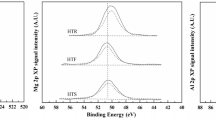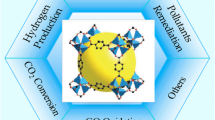Abstract
Core–shell polyionic liquids were successfully constructed to reduce the amount of bulk ionic liquids and realize heterogeneous catalysis in the reaction of CO2 conversion into carbonate. The core–shell polyionic liquid structure is formed by one-step surface polymerization with cheap and readily available SiO2 as the carrier. By optimizing the ratio of ionic liquid monomer to SiO2, PIL@SiO2(1:1.5) of high activity and low ionic liquid dosage was successfully obtained, and only 40% of bulk ionic liquid dosage was used to achieve high activity of quasi-homogeneous phase (PO conversion 95.5%). Combined with the characterization and mechanism study, it was found that at an appropriate ratio (1:1.5), good mesoporous structure and a certain extent dispersion of polyionic liquid can make the active site better dispersed to facilitate the simultaneous activation of multiple molecules, which is the reason for the high activity. In addition, the core–shell structure also has good substrate suitability and recyclability stability. This study provides good ideas for the development of low-cost heterogeneous ionic liquid catalysts.
Graphical Abstract



















Similar content being viewed by others
References
Cheng H, Wang P, Luo J et al (2015) Poly(ionic liquid)-based nanocomposites and their performance in CO2 capture. Ind Eng Chem Res 54(12):3107–3115
Appel AM, Bercaw JE, Bocarsly AB et al (2013) Frontiers, opportunities, and challenges in biochemical and chemical catalysis of CO2 fixation. Chem Rev 113(8):6621–6658
Balaji K, Rabiei M (2022) Carbon dioxide pipeline route optimization for carbon capture, utilization, and storage: a case study for North-Central USA. Sustain Energy Technol Assess 51:101900
Godin J, Liu W, Ren S et al (2021) Advances in recovery and utilization of carbon dioxide: a brief review. J Environ Chem Eng 9(4):105644
North M, Pasquale R, Young C (2010) Synthesis of cyclic carbonates from epoxides and CO2. Green Chem 12(9):1514
Ji L, Luo Z, Zhang Y et al (2018) Imidazolium ionic liquids/organic bases: efficient intermolecular synergistic catalysts for the cycloaddition of CO2 and epoxides under atmospheric pressure. Mol Catal 446:124–130
Sperandio C, Rodriguez J, Quintard A (2020) Organocatalytic carbon dioxide fixation to epoxides by perfluorinated 1,3,5-triols catalysts. Org Biomol Chem 18(14):2637–2640
Udayakumar S, Lee M-K, Shim H-L et al (2009) Functionalization of organic ions on hybrid MCM-41 for cycloaddition reaction: the effective conversion of carbon dioxide. Appl Catal A General 365(1):88–95
Sun J, Yao X, Cheng W et al (2014) 1,3-Dimethylimidazolium-2-carboxylate: a zwitterionic salt for the efficient synthesis of vicinal diols from cyclic carbonates. Green Chem 16(6):3297
Sun J, Wang J, Cheng W et al (2012) Chitosan functionalized ionic liquid as a recyclable biopolymer-supported catalyst for cycloaddition of CO2. Green Chem 14(3):654
Sun J, Cheng W, Yang Z et al (2014) Superbase/cellulose: an environmentally benign catalyst for chemical fixation of carbon dioxide into cyclic carbonates. Green Chem 16(6):3071
Alrefaee SH (2021) Effect of alkyl chain length and halide ions on the corrosion inhibition potential of imidazolium and pyridinium based ionic liquids: computational studies. J Mol Liq 344:117848
Durga G, Kalra P, Kumar Verma V et al (2021) Ionic liquids: From a solvent for polymeric reactions to the monomers for poly(ionic liquids). J Mol Liq 335:116540
Guo Y, Tang Y, He D et al (2021) Preparation and polymerization analysis of poly-(alkenyl-based di-ionic ionic liquid). J Mol Liq 349:118159
Chen J, Wang H, Deng L et al (2021) Synthesis, characterization, and application of metal-free acidic ionic liquids as catalysts for oligomerization of isobutene. Fuel 299:120876
Sun J, Han L, Cheng W et al (2011) Efficient acid-base bifunctional catalysts for the fixation of CO2 with epoxides under metal- and solvent-free conditions. Chemsuschem 4(4):502–507
Ying T, Tan X, Su Q et al (2019) Polymeric ionic liquids tailored by different chain groups for the efficient conversion of CO2 into cyclic carbonates. Green Chem 21(9):2352–2361
Eftekhari A, Saito T (2017) Synthesis and properties of polymerized ionic liquids. Eur Polym J 90:245–272
Dinc M, Esen C, Mizaikoff B (2019) Recent advances on core–shell magnetic molecularly imprinted polymers for biomacromolecules. TrAC Trends Anal Chem 114:202–217
Akala EO, Adesina SK (2018) Fabrication of polymeric core-shell nanostructures. Nanoscale fabrication, optimization, scale-up and biological aspects of pharmaceutical nanotechnology, 1–49
Natongchai W, Luque-Urrutia JA, Phungpanya C et al (2021) Cycloaddition of CO2 to epoxides by highly nucleophilic 4-aminopyridines: establishing a relationship between carbon basicity and catalytic performance by experimental and DFT investigations. Org Chem Front 8(3):613–627
Subramanian S, Park J, Byun J et al (2018) Highly efficient catalytic cyclic carbonate formation by pyridyl salicylimines. ACS Appl Mater Interfaces 10(11):9478–9484
Claver C, Yeamin MB, Reguero M et al (2020) Recent advances in the use of catalysts based on natural products for the conversion of CO2 into cyclic carbonates. Green Chem 22(22):7665–7706
Guo L, Dou R, Wu Y et al (2019) From lignin waste to efficient catalyst: illuminating the impact of lignin structure on catalytic activity of cycloaddition reaction. ACS Sustain Chem Eng 7(19):16585–16594
Jaroonwatana W, Theerathanagorn T, Theerasilp M et al (2021) Nanoparticles of aromatic biopolymers catalyze CO2 cycloaddition to epoxides under atmospheric conditions. Sustain Energy Fuels 5(21):5431–5444
Yue Q, Zhang Y, Jiang Y et al (2017) Nanoengineering of core-shell magnetic mesoporous microspheres with tunable surface roughness. J Am Chem Soc 139(13):4954–4961
Yang W, Li H, Wu Q et al (2020) Functionalized core-shell polystyrene sphere-supported alkaline imidazolium ionic liquid: an efficient and recyclable catalyst for knoevenagel condensation. ACS Sustain Chem Eng 8(49):18126–18137
Rusen E, Diacon A, Mocanu A et al (2018) “A real” emulsion polymerization using simple ATRP reaction in the presence of an oligo-initiator with a dual activity of emulsifier and initiator. Colloids Surf A 555:1–7
Wang P, Zhou Y-N, Luo J-S et al (2014) Poly(ionic liquid)s-based nanocomposite polyelectrolytes with tunable ionic conductivity prepared via SI-ATRP. Polym Chem 5(3):882–891
Robin C, Lorthioir C, Erman A et al (2022) Adsorption of poly(methacrylic acid) onto differently charged silica nanoparticles and its consequences on particles clustering. Colloids Surf A 638:128287
Lang J-Y, Yang Y-S, Wan N, et al (2022) Preparation of boronate-modified larger mesoporous polymer microspheres with fumed silica nanoparticle and toluene as synergistic porogen for selective separation of sulfonamides. Microchem J. https://doi.org/10.2139/ssrn.3940903
Cao J, Wang J, Wang X et al (2022) Preparation and characterization of modified amphiphilic nano-silica for enhanced oil recovery. Colloids Surf A 633:127864
Zeeshan M, Nozari V, Yagci MB et al (2018) Core-shell type ionic liquid/metal organic framework composite: an exceptionally high CO2/CH4 selectivity. J Am Chem Soc 140(32):10113–10116
Ying T, Su Q, Shi Z et al (2019) Polymeric Ionic liquid grafted on silica for efficient conversion of CO2 into cyclic carbonates. Catal Lett 149(10):2647–2655
Liu Y, Cheng W, Zhang Y et al (2017) Controllable preparation of phosphonium-based polymeric ionic liquids as highly selective nanocatalysts for the chemical conversion of CO2 with epoxides. Green Chem 19(9):2184–2193
Du Y-R, Ding G-R, Wang Y-F et al (2021) Construction of a PPIL@COF core–shell composite with enhanced catalytic activity for CO2 conversion [J]. Green Chem 23(6):2411–2419
Su Q, Qi Y, Yao X et al (2018) Ionic liquids tailored and confined by one-step assembly with mesoporous silica for boosting the catalytic conversion of CO2 into cyclic carbonates. Green Chem 20(14):3232–3241
Su Q, Yao X, Cheng W et al (2017) Boron-doped melamine-derived carbon nitrides tailored by ionic liquids for catalytic conversion of CO2 into cyclic carbonates. Green Chem 19(13):2957–2965
Buettner CS, Cognigni A, Schröder C et al (2022) Surface-active ionic liquids: a review. J Mol Liq 347:118160
Maity N, Barman S, Abou-Hamad E et al (2018) Clean chlorination of silica surfaces by a single-site substitution approach. Dalton Trans 47(12):4301–4306
Maity N, Barman S, Minenkov Y et al (2018) A Silica-Supported Monoalkylated Tungsten Dioxo Complex Catalyst for Olefin Metathesis [J]. ACS Catal 8(4):2715–2729
Sodpiban O, Phungpanya C, Del-Gobbo S et al (2021) Rational engineering of single-component heterogeneous catalysts based on abundant metal centers for the mild conversion of pure and impure CO2 to cyclic carbonates. Chem Eng J 422:129930
Acknowledgements
We sincerely acknowledge the National Natural Science Foundation of China (No. 22078329, 21908226, 22178356, 21890763, 22008242).“Transformational Technologies for Clean Energy and Demonstration”, Strategic Priority Research Program of the Chinese Academy of Sciences, Grant No. XDA 21030500, the Key-Area Research and Development Program of Guangdong Province (No.2020B0101370002).
Author information
Authors and Affiliations
Corresponding authors
Ethics declarations
Conflict of interest
The authors declare no conflict of interest.
Additional information
Publisher's Note
Springer Nature remains neutral with regard to jurisdictional claims in published maps and institutional affiliations.
Supplementary Information
Below is the link to the electronic supplementary material.
Rights and permissions
Springer Nature or its licensor holds exclusive rights to this article under a publishing agreement with the author(s) or other rightsholder(s); author self-archiving of the accepted manuscript version of this article is solely governed by the terms of such publishing agreement and applicable law.
About this article
Cite this article
Liu, S., Su, Q., Fu, M. et al. Core–Shell Dispersed Polymeric Ionic Liquids as Efficient Heterogeneous Catalyst for CO2 Conversion into Cyclic Carbonates. Catal Lett 153, 2429–2442 (2023). https://doi.org/10.1007/s10562-022-04103-2
Received:
Accepted:
Published:
Issue Date:
DOI: https://doi.org/10.1007/s10562-022-04103-2




